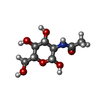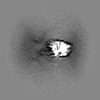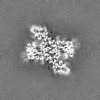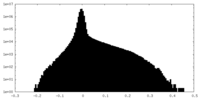+ Open data
Open data
- Basic information
Basic information
| Entry |  | |||||||||||||||||||||
|---|---|---|---|---|---|---|---|---|---|---|---|---|---|---|---|---|---|---|---|---|---|---|
| Title | PSMA in complex with nanobody 7 and 8 | |||||||||||||||||||||
 Map data Map data | PSMA with nanobodies 7 and 8 | |||||||||||||||||||||
 Sample Sample |
| |||||||||||||||||||||
 Keywords Keywords | carboxypeptidase complex nanobody / MEMBRANE PROTEIN | |||||||||||||||||||||
| Function / homology |  Function and homology information Function and homology informationAc-Asp-Glu binding / tetrahydrofolyl-poly(glutamate) polymer binding / glutamate carboxypeptidase II / folic acid-containing compound metabolic process / C-terminal protein deglutamylation / Aspartate and asparagine metabolism / dipeptidase activity / carboxypeptidase activity / metallocarboxypeptidase activity / peptidase activity ...Ac-Asp-Glu binding / tetrahydrofolyl-poly(glutamate) polymer binding / glutamate carboxypeptidase II / folic acid-containing compound metabolic process / C-terminal protein deglutamylation / Aspartate and asparagine metabolism / dipeptidase activity / carboxypeptidase activity / metallocarboxypeptidase activity / peptidase activity / cell surface / proteolysis / extracellular exosome / metal ion binding / membrane / plasma membrane / cytoplasm Similarity search - Function | |||||||||||||||||||||
| Biological species |   Homo sapiens (human) / Homo sapiens (human) /  | |||||||||||||||||||||
| Method | single particle reconstruction / cryo EM / Resolution: 3.0 Å | |||||||||||||||||||||
 Authors Authors | Alon G / Zalk R / Huynh TT / Zalutsky MR / Weizmann Y / Zarivach R / Papo N | |||||||||||||||||||||
| Funding support |  Israel, Israel,  United States, United States,  United Kingdom, 6 items United Kingdom, 6 items
| |||||||||||||||||||||
 Citation Citation |  Journal: Int J Biol Macromol / Year: 2025 Journal: Int J Biol Macromol / Year: 2025Title: Structural analysis of nanobody interactions with their prostate-specific membrane antigen binding epitopes. Authors: Gal Alon-Zchut / Ran Zalk / Truc T Huynh / Michael R Zalutsky / Yossi Weizmann / Raz Zarivach / Niv Papo /   Abstract: Prostate-specific membrane antigen (PSMA), overexpressed in prostate cancer, is a promising target for diagnostics and therapy. However, the monoclonal antibodies in current use for PSMA targeting ...Prostate-specific membrane antigen (PSMA), overexpressed in prostate cancer, is a promising target for diagnostics and therapy. However, the monoclonal antibodies in current use for PSMA targeting and inhibition have suboptimal activities due to their poor tissue and cell penetration and slow normal tissue clearance. Potentially superior alternatives are nanobodies (NBs), the single-chain variable domains of heavy-chain antibodies derived from camelids. The advantages of NBs include small size (~15 kDa), ability to bind hidden epitopes, and rapid clearance. In contrast to most known PSMA inhibitors, which bind to the same catalytic site in PMSA, NBs can bind to different PSMA epitopes, facilitating heterovalent binding strategies that could enhance their therapeutic and diagnostic potential. The objective of this study was to map these binding epitopes and hence to acquire an atomic-resolution understanding of NB-PMSA binding by investigating the structural interactions between PSMA and three NBs (NB7, NB8, and NB37). Using cryo-electron microscopy to generate high-resolution structures of NB-PSMA complexes, we found that NB7 had the highest affinity for PSMA due to a larger interface and to stabilizing interactions, including salt bridges and π-π stacking. Notably, we also found that NB7 and NB8 can bind simultaneously to different PSMA epitopes without interfering with the function of PSMA (which is still not completely known), opening the way for the development of theranostic applications for prostate cancer treatment and imaging. Importantly, NB7 binds specifically to human PSMA but not to murine PSMA, due to key amino acid differences responsible for its species specificity. | |||||||||||||||||||||
| History |
|
- Structure visualization
Structure visualization
| Supplemental images |
|---|
- Downloads & links
Downloads & links
-EMDB archive
| Map data |  emd_52436.map.gz emd_52436.map.gz | 31.7 MB |  EMDB map data format EMDB map data format | |
|---|---|---|---|---|
| Header (meta data) |  emd-52436-v30.xml emd-52436-v30.xml emd-52436.xml emd-52436.xml | 20 KB 20 KB | Display Display |  EMDB header EMDB header |
| FSC (resolution estimation) |  emd_52436_fsc.xml emd_52436_fsc.xml | 8.5 KB | Display |  FSC data file FSC data file |
| Images |  emd_52436.png emd_52436.png | 82.3 KB | ||
| Filedesc metadata |  emd-52436.cif.gz emd-52436.cif.gz | 6.9 KB | ||
| Others |  emd_52436_half_map_1.map.gz emd_52436_half_map_1.map.gz emd_52436_half_map_2.map.gz emd_52436_half_map_2.map.gz | 59.4 MB 59.4 MB | ||
| Archive directory |  http://ftp.pdbj.org/pub/emdb/structures/EMD-52436 http://ftp.pdbj.org/pub/emdb/structures/EMD-52436 ftp://ftp.pdbj.org/pub/emdb/structures/EMD-52436 ftp://ftp.pdbj.org/pub/emdb/structures/EMD-52436 | HTTPS FTP |
-Validation report
| Summary document |  emd_52436_validation.pdf.gz emd_52436_validation.pdf.gz | 755.2 KB | Display |  EMDB validaton report EMDB validaton report |
|---|---|---|---|---|
| Full document |  emd_52436_full_validation.pdf.gz emd_52436_full_validation.pdf.gz | 754.8 KB | Display | |
| Data in XML |  emd_52436_validation.xml.gz emd_52436_validation.xml.gz | 16.4 KB | Display | |
| Data in CIF |  emd_52436_validation.cif.gz emd_52436_validation.cif.gz | 21.4 KB | Display | |
| Arichive directory |  https://ftp.pdbj.org/pub/emdb/validation_reports/EMD-52436 https://ftp.pdbj.org/pub/emdb/validation_reports/EMD-52436 ftp://ftp.pdbj.org/pub/emdb/validation_reports/EMD-52436 ftp://ftp.pdbj.org/pub/emdb/validation_reports/EMD-52436 | HTTPS FTP |
-Related structure data
| Related structure data |  9hvkMC  9hlwC  9hviC  9hvlC M: atomic model generated by this map C: citing same article ( |
|---|---|
| Similar structure data | Similarity search - Function & homology  F&H Search F&H Search |
- Links
Links
| EMDB pages |  EMDB (EBI/PDBe) / EMDB (EBI/PDBe) /  EMDataResource EMDataResource |
|---|---|
| Related items in Molecule of the Month |
- Map
Map
| File |  Download / File: emd_52436.map.gz / Format: CCP4 / Size: 64 MB / Type: IMAGE STORED AS FLOATING POINT NUMBER (4 BYTES) Download / File: emd_52436.map.gz / Format: CCP4 / Size: 64 MB / Type: IMAGE STORED AS FLOATING POINT NUMBER (4 BYTES) | ||||||||||||||||||||||||||||||||||||
|---|---|---|---|---|---|---|---|---|---|---|---|---|---|---|---|---|---|---|---|---|---|---|---|---|---|---|---|---|---|---|---|---|---|---|---|---|---|
| Annotation | PSMA with nanobodies 7 and 8 | ||||||||||||||||||||||||||||||||||||
| Projections & slices | Image control
Images are generated by Spider. | ||||||||||||||||||||||||||||||||||||
| Voxel size | X=Y=Z: 0.89 Å | ||||||||||||||||||||||||||||||||||||
| Density |
| ||||||||||||||||||||||||||||||||||||
| Symmetry | Space group: 1 | ||||||||||||||||||||||||||||||||||||
| Details | EMDB XML:
|
-Supplemental data
-Half map: PSMA with nanobodies 7 and 8 halfA
| File | emd_52436_half_map_1.map | ||||||||||||
|---|---|---|---|---|---|---|---|---|---|---|---|---|---|
| Annotation | PSMA with nanobodies 7 and 8 halfA | ||||||||||||
| Projections & Slices |
| ||||||||||||
| Density Histograms |
-Half map: PSMA with nanobodies 7 and 8 halfB
| File | emd_52436_half_map_2.map | ||||||||||||
|---|---|---|---|---|---|---|---|---|---|---|---|---|---|
| Annotation | PSMA with nanobodies 7 and 8 halfB | ||||||||||||
| Projections & Slices |
| ||||||||||||
| Density Histograms |
- Sample components
Sample components
-Entire : PSMA in complex with nanobody 8
| Entire | Name: PSMA in complex with nanobody 8 |
|---|---|
| Components |
|
-Supramolecule #1: PSMA in complex with nanobody 8
| Supramolecule | Name: PSMA in complex with nanobody 8 / type: complex / ID: 1 / Parent: 0 / Macromolecule list: #1-#2 |
|---|---|
| Source (natural) | Organism:  |
| Molecular weight | Theoretical: 230 KDa |
-Macromolecule #1: Glutamate carboxypeptidase 2
| Macromolecule | Name: Glutamate carboxypeptidase 2 / type: protein_or_peptide / ID: 1 / Number of copies: 2 / Enantiomer: LEVO / EC number: glutamate carboxypeptidase II |
|---|---|
| Source (natural) | Organism:  Homo sapiens (human) Homo sapiens (human) |
| Molecular weight | Theoretical: 78.341352 KDa |
| Recombinant expression | Organism:  |
| Sequence | String: HNMKAFLDEL KAENIKKFLY NFTQIPHLAG TEQNFQLAKQ IQSQWKEFGL DSVELAHYDV LLSYPNKTHP NYISIINEDG NEIFNTSLF EPPPPGYENV SDIVPPFSAF SPQGMPEGDL VYVNYARTED FFKLERDMKI NCSGKIVIAR YGKVFRGNKV K NAQLAGAK ...String: HNMKAFLDEL KAENIKKFLY NFTQIPHLAG TEQNFQLAKQ IQSQWKEFGL DSVELAHYDV LLSYPNKTHP NYISIINEDG NEIFNTSLF EPPPPGYENV SDIVPPFSAF SPQGMPEGDL VYVNYARTED FFKLERDMKI NCSGKIVIAR YGKVFRGNKV K NAQLAGAK GVILYSDPAD YFAPGVKSYP DGWNLPGGGV QRGNILNLNG AGDPLTPGYP ANEYAYRRGI AEAVGLPSIP VH PIGYYDA QKLLEKMGGS APPDSSWRGS LKVPYNVGPG FTGNFSTQKV KMHIHSTNEV TRIYNVIGTL RGAVEPDRYV ILG GHRDSW VFGGIDPQSG AAVVHEIVRS FGTLKKEGWR PRRTILFASW DAEEFGLLGS TEWAEENSRL LQERGVAYIN ADSS IEGNY TLRVDCTPLM YSLVHNLTKE LKSPDEGFEG KSLYESWTKK SPSPEFSGMP RISKLGSGND FEVFFQRLGI ASGRA RYTK NWETNKFSGY PLYHSVYETY ELVEKFYDPM FKYHLTVAQV RGGMVFELAN SIVLPFDCRD YAVVLRKYAD KIYSIS MKH PQEMKTYSVS FDSLFSAVKN FTEIASKFSE RLQDFDKSNP IVLRMMNDQL MFLERAFIDP LGLPDRPFYR HVIYAPS SH NKYAGESFPG IYDALFDIES KVDPSKAWGE VKRQIYVAAF TVQAAAETLS EVA UniProtKB: Glutamate carboxypeptidase 2 |
-Macromolecule #2: Nanobody 7
| Macromolecule | Name: Nanobody 7 / type: protein_or_peptide / ID: 2 / Number of copies: 2 / Enantiomer: LEVO |
|---|---|
| Source (natural) | Organism:  |
| Molecular weight | Theoretical: 13.79518 KDa |
| Recombinant expression | Organism:  |
| Sequence | String: QVQLQESGGG SVQAGGSLRL SCTAPGYTDS NYYMSWFRQA PGKEREWVAG VNTGRGSTSY ADSVKGRFTI SQDNAKNTMF LQMNSLKPE DTAQYYCAVA ACHFCDSLPK TQDEYILWGQ GTQVTVS |
-Macromolecule #3: Nanobody 8
| Macromolecule | Name: Nanobody 8 / type: protein_or_peptide / ID: 3 / Number of copies: 2 / Enantiomer: LEVO |
|---|---|
| Source (natural) | Organism:  |
| Molecular weight | Theoretical: 13.299545 KDa |
| Recombinant expression | Organism:  |
| Sequence | String: VQLQESGGGS VQAGGSLRLS CARSGWPYST YSMNWFRQAP GKEREAVAGI SSTMSGIIFA ESKAGQFTIS QDNAKNTVYL QMNNLKPED TAIYYCAARR DYSLSSSSDD FDYWGQGTQV TVS |
-Macromolecule #7: 2-acetamido-2-deoxy-beta-D-glucopyranose
| Macromolecule | Name: 2-acetamido-2-deoxy-beta-D-glucopyranose / type: ligand / ID: 7 / Number of copies: 8 / Formula: NAG |
|---|---|
| Molecular weight | Theoretical: 221.208 Da |
| Chemical component information |  ChemComp-NAG: |
-Macromolecule #8: ZINC ION
| Macromolecule | Name: ZINC ION / type: ligand / ID: 8 / Number of copies: 4 / Formula: ZN |
|---|---|
| Molecular weight | Theoretical: 65.409 Da |
-Macromolecule #9: CALCIUM ION
| Macromolecule | Name: CALCIUM ION / type: ligand / ID: 9 / Number of copies: 2 / Formula: CA |
|---|---|
| Molecular weight | Theoretical: 40.078 Da |
-Macromolecule #10: CHLORIDE ION
| Macromolecule | Name: CHLORIDE ION / type: ligand / ID: 10 / Number of copies: 1 / Formula: CL |
|---|---|
| Molecular weight | Theoretical: 35.453 Da |
-Experimental details
-Structure determination
| Method | cryo EM |
|---|---|
 Processing Processing | single particle reconstruction |
| Aggregation state | particle |
- Sample preparation
Sample preparation
| Buffer | pH: 8 |
|---|---|
| Vitrification | Cryogen name: ETHANE / Instrument: HOMEMADE PLUNGER / Details: manually blotted for 3 seconds. |
- Electron microscopy
Electron microscopy
| Microscope | TFS GLACIOS |
|---|---|
| Image recording | Film or detector model: TFS FALCON 4i (4k x 4k) / Average electron dose: 30.0 e/Å2 |
| Electron beam | Acceleration voltage: 200 kV / Electron source:  FIELD EMISSION GUN FIELD EMISSION GUN |
| Electron optics | Illumination mode: FLOOD BEAM / Imaging mode: BRIGHT FIELD / Nominal defocus max: 2.0 µm / Nominal defocus min: 0.5 µm |
 Movie
Movie Controller
Controller









 Z (Sec.)
Z (Sec.) Y (Row.)
Y (Row.) X (Col.)
X (Col.)





































